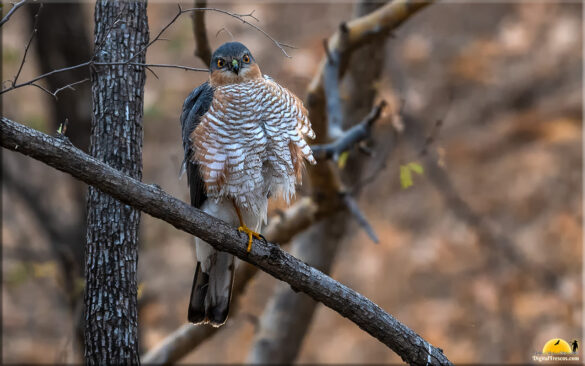
The Eurasian sparrowhawk, also known as the northern sparrowhawk or simply the sparrowhawk, is a small bird of prey. Adult male as seen in this picture have bluish grey upperparts and orange-barred underparts; females and juveniles are brown above with brown barring below. The female is up to 25% larger than the male – one of the greatest size differences between the sexes in any bird species. Though it is a predator which specialises in catching woodland birds, the Eurasian sparrowhawk can be found in any habitat and often hunts garden birds in towns and cities. Males tend to take smaller birds, including tits, finches, and sparrows. The Eurasian sparrowhawk is found throughout the temperate and subtropical parts of the Old World; while birds from the northern parts of the range migrate south for winter, their southern counterparts remain resident or make dispersive movements. Eurasian sparrowhawks breed in suitable woodland of any type, with the nest, measuring up to 60 cm (2.0 ft) across, built using twigs in a tree. Four or five pale blue, brown-spotted eggs are laid; the success of the breeding attempt is dependent on the female maintaining a high weight while the male brings her food. […]
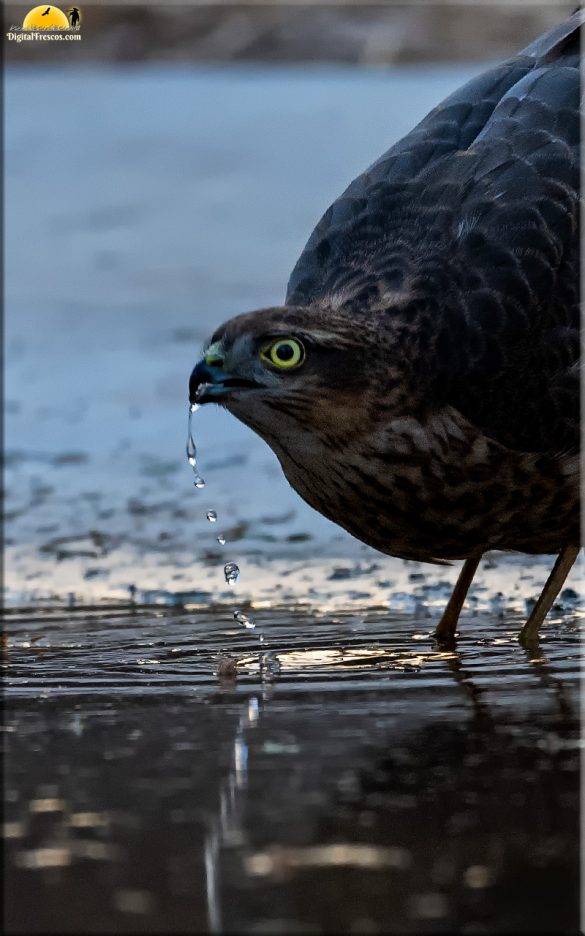
The Eurasian sparrowhawk, also known as the northern sparrowhawk or simply the sparrowhawk, is a small bird of prey. The female sparrowhawk is seen here taking a splash in water at the end of a hot winter day. Adult male have bluish grey upperparts and orange-barred underparts; females and juveniles are brown above with brown barring below. The female is up to 25% larger than the male – one of the greatest size differences between the sexes in any bird species. Though it is a predator which specialises in catching woodland birds, the Eurasian sparrowhawk can be found in any habitat and often hunts garden birds in towns and cities. Males tend to take smaller birds, including tits, finches, and sparrows. The Eurasian sparrowhawk is found throughout the temperate and subtropical parts of the Old World; while birds from the northern parts of the range migrate south for winter, their southern counterparts remain resident or make dispersive movements. Eurasian sparrowhawks breed in suitable woodland of any type, with the nest, measuring up to 60 cm (2.0 ft) across, built using twigs in a tree. Four or five pale blue, brown-spotted eggs are laid; the success of the breeding attempt is […]
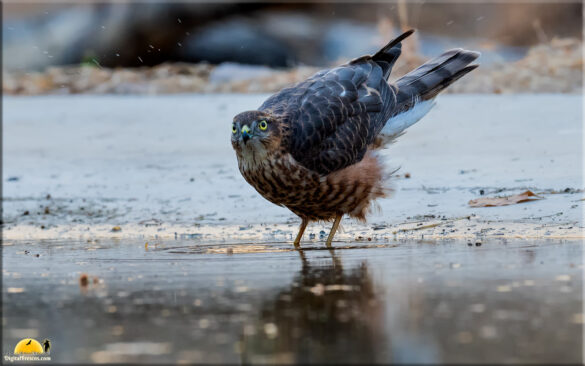
The Eurasian sparrowhawk, also known as the northern sparrowhawk or simply the sparrowhawk, is a small bird of prey. The female sparrowhawk is seen here taking a splash in water at the end of a hot winter day. Adult male have bluish grey upperparts and orange-barred underparts; females and juveniles are brown above with brown barring below. The female is up to 25% larger than the male – one of the greatest size differences between the sexes in any bird species. Though it is a predator which specialises in catching woodland birds, the Eurasian sparrowhawk can be found in any habitat and often hunts garden birds in towns and cities. Males tend to take smaller birds, including tits, finches, and sparrows. The Eurasian sparrowhawk is found throughout the temperate and subtropical parts of the Old World; while birds from the northern parts of the range migrate south for winter, their southern counterparts remain resident or make dispersive movements. Eurasian sparrowhawks breed in suitable woodland of any type, with the nest, measuring up to 60 cm (2.0 ft) across, built using twigs in a tree. Four or five pale blue, brown-spotted eggs are laid; the success of the breeding attempt is […]
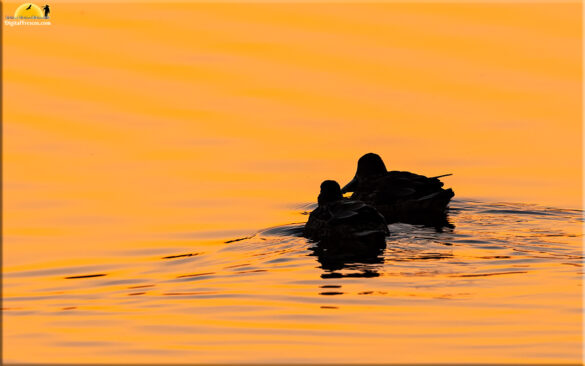
The northern shoveler, known simply in Britain as the shoveler, is a common and widespread duck. It breeds in northern areas of Europe and Asia and across most of North America, wintering in southern Europe, Africa, the Indian subcontinent, Southeast Asia, and Central, and northern South America. It is a rare vagrant to Australia. In North America, it breeds along the southern edge of Hudson Bay and west of this body of water, and as far south as the Great Lakes west to Colorado, Nevada, and Oregon. It is strongly migratory and winters further south than its breeding range. It has occasionally been reported as a vagrant as far south as Australia, New Zealand and South Africa. This species is unmistakable in the northern hemisphere due to its large spatulate bill. The breeding drake has an iridescent dark green head, white breast and chestnut belly and flanks. In flight, pale blue forewing feathers are revealed, separated from the green speculum by a white border. In early fall the male will have a white crescent on each side of the face. In non-breeding (eclipse) plumage, the drake resembles the female. The female is a drab mottled brown like other dabblers, […]
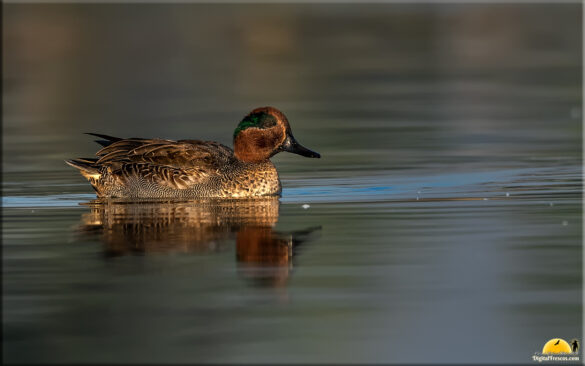
The Eurasian teal or common teal is a common and widespread duck which breeds in temperate Eurasia and migrates south in winter. The Eurasian teal is often called simply the teal due to being the only one of these small dabbling ducks in much of its range. The bird gives its name to the blue-green colour teal. It is a highly gregarious duck outside the breeding season and can form large flocks. It is commonly found in sheltered wetlands and feeds on seeds and aquatic invertebrates. From a distance, the drakes in nuptial plumage appear grey, with a dark head, a yellowish behind, and a white stripe running along the flanks. Their head and upper neck is chestnut, with a wide and iridescent dark green patch of half-moon- or teardrop-shape that starts immediately before the eye and arcs to the upper hindneck. The Eurasian teal is the smallest extant dabbling duck. In flight, the fast, twisting flocks resemble waders; despite its short legs, it is also rather nimble on the ground by ducks’ standards. In the breeding season, it is a common inhabitant of sheltered freshwater wetlands with some tall vegetation, such as taiga bogs or small lakes and ponds […]

The northern shoveler, known simply in Britain as the shoveler, is a common and widespread duck. It breeds in northern areas of Europe and Asia and across most of North America, wintering in southern Europe, Africa, the Indian subcontinent, Southeast Asia, and Central, and northern South America. It is a rare vagrant to Australia. In North America, it breeds along the southern edge of Hudson Bay and west of this body of water, and as far south as the Great Lakes west to Colorado, Nevada, and Oregon. It is strongly migratory and winters further south than its breeding range. It has occasionally been reported as a vagrant as far south as Australia, New Zealand and South Africa. This species is unmistakable in the northern hemisphere due to its large spatulate bill. The breeding drake has an iridescent dark green head, white breast and chestnut belly and flanks. In flight, pale blue forewing feathers are revealed, separated from the green speculum by a white border. In early fall the male will have a white crescent on each side of the face. In non-breeding (eclipse) plumage, the drake resembles the female. The female is a drab mottled brown like other dabblers, with […]
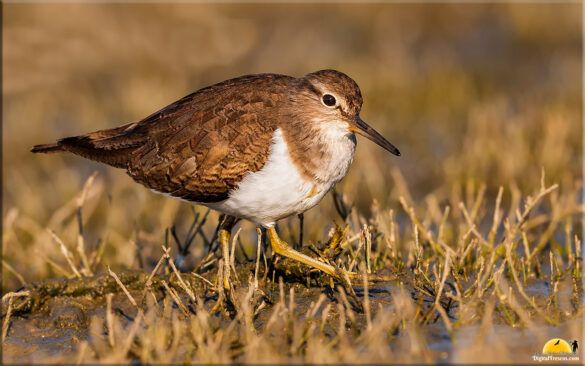
The common sandpiper is a small Palearctic wader. This bird and its American sister species, the spotted sandpiper, make up the genus Actitis. They are parapatric and replace each other geographically; stray birds of either species may settle down with breeders of the other and hybridize. Hybridization has also been reported between the common sandpiper and the green sandpiper, a basal species of the closely related shank genus Tringa. It is a gregarious bird and is seen in large flocks, and has the distinctive stiff-winged flight, low over the water, of Actitis waders. The common sandpiper breeds across most of temperate and subtropical Europe and Asia, and migrates to Africa, southern Asia and Australia in winter. The eastern edge of its migration route passes by Palau in Micronesia, where hundreds of birds may gather for a stop-over. They depart the Palau region for their breeding quarters around the last week of April to the first week of May. The common sandpiper forages by sight on the ground or in shallow water, picking up small food items such as insects, crustaceans and other invertebrates; it may even catch insects in flight. It is classified as least concern by IUCN.

The northern shoveler, known simply in Britain as the shoveler, is a common and widespread duck. It breeds in northern areas of Europe and Asia and across most of North America, wintering in southern Europe, Africa, the Indian subcontinent, Southeast Asia, and Central, and northern South America. It is a rare vagrant to Australia. In North America, it breeds along the southern edge of Hudson Bay and west of this body of water, and as far south as the Great Lakes west to Colorado, Nevada, and Oregon. It is strongly migratory and winters further south than its breeding range. It has occasionally been reported as a vagrant as far south as Australia, New Zealand and South Africa. This species is unmistakable in the northern hemisphere due to its large spatulate bill. The breeding drake has an iridescent dark green head, white breast and chestnut belly and flanks. In flight, pale blue forewing feathers are revealed, separated from the green speculum by a white border. In early fall the male will have a white crescent on each side of the face. In non-breeding (eclipse) plumage, the drake resembles the female. The female is a drab mottled brown like other dabblers, with […]
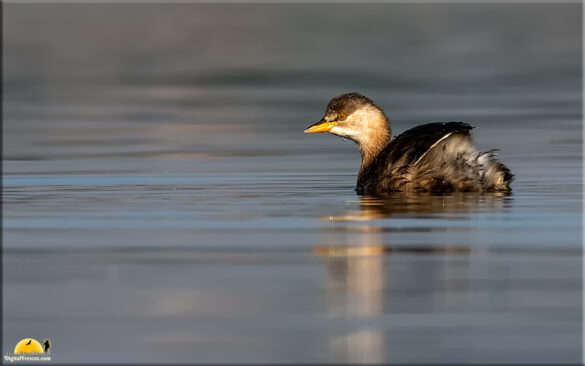
The little grebe is a small water bird with a pointed bill. The adult is unmistakable in summer, predominantly dark above with its rich, rufous colour neck, cheeks and flanks, and bright yellow gape. The rufous is replaced by a dirty brownish grey in non-breeding and juvenile birds. Juvenile birds have a yellow bill with a small black tip, and black and white streaks on the cheeks and sides of the neck as seen below. This yellow bill darkens as the juveniles age, eventually turning black in adulthood. In winter, its size, buff plumage, with a darker back and cap, and “powder puff” rear end enable easy identification of this species. The little grebe’s breeding call, given singly or in duet, is a trilled repeated weet-weet-weet or wee-wee-wee which sounds like a horse whinnying. The little grebe is an excellent swimmer and diver and pursues its fish and aquatic invertebrate prey underwater. It uses the vegetation skillfully as a hiding place. Like all grebes, it nests at the water’s edge, since its legs are set very far back and it cannot walk well. Usually four to seven eggs are laid. When the adult bird leaves the nest it usually takes […]
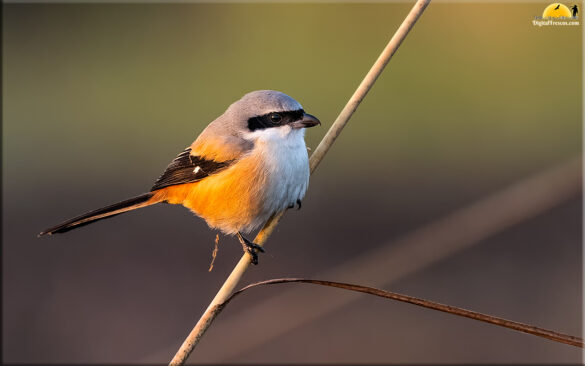
The long-tailed shrike or rufous-backed shrike is a member of the bird family Laniidae, the shrikes. They are found widely distributed across Asia and there are variations in plumage across the range. The species ranges across much of Asia, both on the mainland and the eastern archipelagos. The eastern or Himalayan subspecies, L. s. tricolor, is sometimes called the black-headed shrike. Although there are considerable differences in plumage among the subspecies, they all have a long and narrow black tail, have a black mask and forehead, rufous rump and flanks and a small white patch on the shoulder. The species is found across Asia from Kazakhstan to New Guinea. It is found mainly in scrub and open habitats. Many of the temperate zone populations are migratory, moving south in winter while those in the tropics tend to be sedentary although they may make short distance movements. Subspecies caniceps of southern India is found in winter in the dry coastal zone of southern India. This bird has a characteristic upright “shrike” attitude when perched on a bush, from which it glides down at an angle to take lizards, large insects, small birds and rodents. They maintain feeding territories and are usually […]
The common kingfisher also known as the small blue kingfisher, Eurasian kingfisher, and river kingfisher, is a small kingfisher with seven subspecies recognized within its wide distribution across Eurasia and North Africa. It is resident in much of its range, but migrates from areas where rivers freeze in winter. Like all kingfishers, the common kingfisher is highly territorial; since it must eat around 60% of its body weight each day, it is essential to have control of a suitable stretch of river. It is solitary for most of the year, roosting alone in heavy cover. If another kingfisher enters its territory, both birds display from perches, and fights may occur, in which a bird will grab the other’s beak and try to hold it under water. The common kingfisher hunts from a perch above the water, on a branch, post or riverbank, bill pointing down as it searches for prey. It bobs its head when food is detected to gauge the distance, and plunges steeply down to seize its prey usually below the surface. The wings are opened under water and the open eyes are protected by the transparent third eyelid. The bird rises beak-first from the surface and flies […]
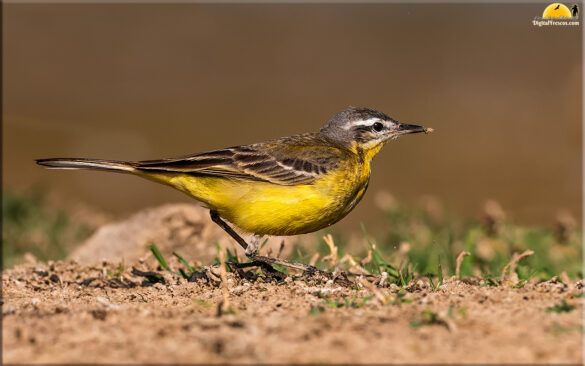
The yellow wagtail is a small, graceful, yellow and green bird, with a medium-length tail and slender black legs. It spends much time walking or running on the ground. As its name implies, it wags its tail from time to time. This species breeds in much of temperate Europe and Asia. It is resident in the milder parts of its range, such as western Europe, but northern and eastern populations migrate to Africa and south Asia. It is a slender 15–16 cm long bird, with the characteristic long, constantly wagging tail of its genus. It is the shortest tailed of the European wagtails. The breeding adult male is basically olive above and yellow below. In other plumages, the yellow may be diluted by white. The heads of breeding males come in a variety of colours and patterns depending on subspecies. This insectivorous bird inhabits open country near water, such as wet meadows. It nests in tussocks, laying 4-8 speckled eggs. This species’ systematics and phylogeny is extremely confusing. Literally dozens of subspecies have been described at one time or another, and some 15-20 are currently considered valid. In addition, the citrine wagtail (M. citreola) forms a cryptic species complex with […]

The white wagtail is a small passerine bird in the family Motacillidae, which also includes pipits and longclaws. The species breeds in much of Europe and Asia and parts of North Africa. It has a toehold in Alaska as a scarce breeder. It is resident in the mildest parts of its range, but otherwise migrates to Africa. In Ireland and Great Britain, the darker subspecies, the pied wagtail predominates. The white wagtail (Indian pied wagtail) is an insectivorous bird of open country, often near habitation and water. It prefers bare areas for feeding, where it can see and pursue its prey. In urban areas it has adapted to foraging on paved areas such as car parks. It nests in crevices in stone walls and similar natural and man-made structures. The white wagtail is the national bird of Latvia. Nine or eleven subspecies are currently recognised. Information on the plumage differences and distribution of the subspecies of the white wagtail is shown below. This particular individual is M. a. dukhunensis sub species – Indian pied wagtail. This breeds in West Siberian Plain – east Caspian Sea (part of Russia, Kazakhstan, Uzbekistan, Turkmenistan), winters in the Middle East, India and Bangladesh. It […]

The common snipe is a meduim-sized wading bird with a long, straight, pointed, black bill. It has a brown body with black bars, a striped head and back and a white belly. The common snipe is a small, stocky wader native to the Old World. Common snipe can be found in wet grassy areas of freshwater marshes, ponds, flooded meadows, fields and occasionally, salt marshes. The breeding habitat is marshes, bogs, tundra and wet meadows throughout northern Europe and northern Asia. It is migratory, with European birds wintering in southern and western Europe and Africa (south to the Equator), and Asian migrants moving to tropical southern Asia. It is a well camouflaged bird, it is usually shy and conceals itself close to ground vegetation and flushes only when approached closely. When flushed, they utter a sharp note that sounds like scape, scape and fly off in a series of aerial zig-zags to confuse predators.[9] They forage in soft mud, probing or picking up food by sight. They mainly eat insects and earthworms, also some plant material. It is classified as least concern by IUCN.